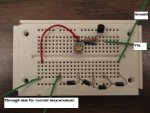- Joined
- Feb 23, 2008
- Messages
- 2,832
- Points
- 48
ok i just got finished making my driver but i guess i did something wrong b/c im not getting a mA reading at all on my dmm. i checked voltage coming in(5.99-6v from 2 cr123a batts) and voltage going out(between 5.35-5.37v) but no rating at all on mA setting. any1 have an idea where i may have went wrong? i used the parts from the post above and etched a pcb for them. i have already double checked the data sheets for the products to make sure all pinouts were correct.








